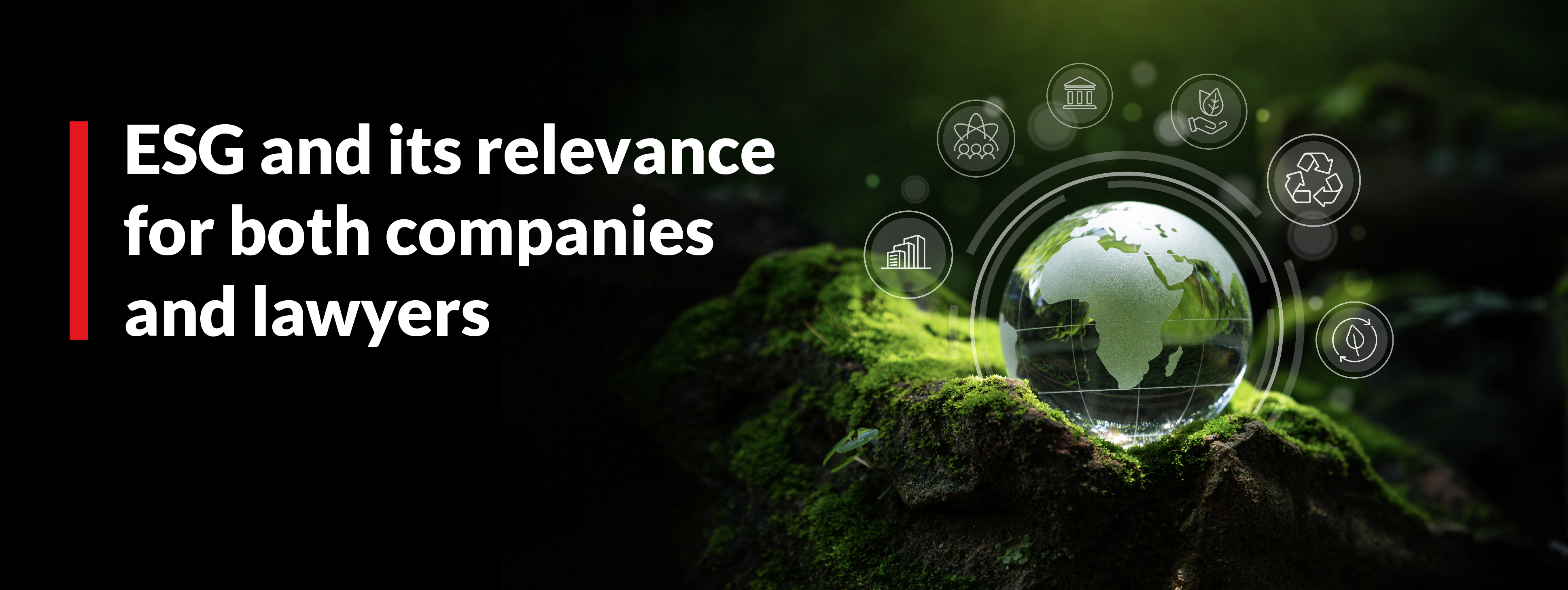
ESG and its relevance for both companies and lawyers
25 January 2023 00:00
How can you understand what ESG (Environment, Social and Governance) is, and how it is relevant to your organisation and to your legal team? What can you do to ensure that your ESG policies are legitimate and make a real impact?
The changing regulatory landscape and significance of ESG policies in the public eye are forcing organisations to reconsider their implementation of ESG. So, what are the fundamentals of Environmental, Social, and Governance (ESG) as a concept and what do you need to know about it?
This article from the experts behind Practical Guidance Corporations covers the rapidly increasing relevance of ESG for lawyers and the key steps involved in undertaking ESG due diligence. You can quickly access up-to-date legal, regulatory, and compliance information from within Practical Guidance using the Toolkit for ESG (Environmental, Social and Governance) Resources in Practical Guidance. Subscribers can access the complete toolkit HERE.
What is ESG?
[FREE DOWNLOAD] Checklist of legal requirements for company directors: Climate-related ESG risks
The acronym “ESG” is an umbrella term used to refer to the environmental (“E”), social (“S”), and governance (“G”) aspects of an activity. The term “ESG” is increasingly used in a corporate or commercial setting by institutional investors who recognise the importance of ESG factors, given their influence on an investment portfolio’s risk and return profile.
Each prong within the ESG umbrella can be summarised as follows:
| Environmental | Social | Governance |
The quality or functioning of the natural environment, or more specifically, the company’s impact on the natural environment or the impact of the environment on the company. This prong is growing in dominance within the ESG space, with Australia being one of the leading jurisdictions of climate change litigation. Key benchmark: Paris Agreement on Climate Change | The rights, well-being and interests of people and communities. Put another way, it concerns the company’s social impacts on its stakeholders, i.e., how does the company treat its employees, customers, and communities? It can also be thought of as human rights impacts. Key benchmark: 2011 United Nations Guiding Principles on Business and Human Rights | The governance, integrity and accountability of companies. Good governance is a key ESG factor for investors who consider the risk to their investments from ESG-related issues, and inversely the opportunities for value creation that may be realised through ESG, to be significant. See also ASX Corporate Governance Council’s Corporate Governance Principles and Recommendations (4th ed), 2019. Key benchmark: OECD Convention on Combating Bribery of Foreign Public Officials in International Business Transactions |
Each ESG prong can be broken down further into common ESG issues, as shown in the following table. There is of course no definitive list of ESG issues. Many issues can be called an “ESG issue” and the scope of “ESG issues” itself changes over time alongside ever-changing views held by society and investors.
With these considerations in mind, the ESG issues listed in the table are useful for illustrating how each “E”, “S” and “G” prong can be understood:
| Environmental | Social | Governance |
Climate change and emissions | Anti-discrimination, bullying and harassment | Anti-bribery and corruption, and anti-money laundering and counter-terrorism financing |
Biodiversity | Native title, indigenous rights, cultural heritage | Internal corporate governance and accountability, including board independence, diversity and structure, and board ethics |
Resource use & depletion (eg water scarcity, deforestation) | Labour & employment | Executive pay |
Contamination and pollution | Human rights | Tax governance/risk |
Waste | Diversity and inclusion Management of supply chain integrity Product safety and liability Local communities & engagement Data protection and privacy | Shareholder rights Political lobbying and donations |
There is nothing particularly new or revolutionary about the ESG issues that companies face at present or will face in the future. However, in recent years, the concept of “ESG” has started to emerge as a key, distinct priority for companies and their stakeholders. The importance of ESG for Australian companies has been driven by such as investors, laws, regulators, society and local communities, and businesses themselves.
What “ESG” means for one company will not necessarily be the same as what it means for another. The scope of a company’s ESG issues will depend on factors such as the industry it operates in, the nature of its activities, stakeholders, and sectors or jurisdictions in which it operates. Further, ESG is not a static concept; over time, and depending on the context, ESG issues relevant to a particular company will develop and evolve, and different ESG issues will take on varying degrees of importance.
What should companies be doing about ESG?
ESG is relevant across all parts of a company, from the board and all the way down. The relevance of ESG even extends beyond the company itself, reaching the company’s supply chain, business partners, government and local communities.
The importance of ESG for companies means that they ignore ESG at their own peril. Companies that want to put themselves in a good position in relation to ESG can take the following key practical steps:
- Ensure the board understands and is kept up to date on key ESG risks and opportunities. The board should know how and when key ESG issues and opportunities may affect (adversely or positively) the company’s strategy and vision. With this knowledge, the board should then set the agenda for the company “from the top” by ensuring that the company’s strategic direction will meet its ESG obligations.
- Develop a company-wide position on key ESG issues, noting that:
- ESG issues of relevance to the company may shift over time and will therefore need to be revisited and amended from time to time;
- it would be useful to investigate what the industry and other peers are doing on ESG, and to find out the expectations of key stakeholders; and
- it is important to undertake a materiality assessment (initially and on an ongoing basis) to identify and understand exactly which ESG issues are relevant to the company and then prioritise actions to address those issues.
- The board may need to consider forming a committee that draws on expertise across the organisation to discharge this function. Where companies do not have the appropriate internal resources to cover all ESG issues (which is not uncommon), they may need to obtain advice from external experts.
- Formulate a specific ESG framework to incorporate oversight and management of the company’s ESG performance, and of ESG risks and opportunities, into the company’s own governance processes. It can be difficult for boards to get an overall picture of the company’s ESG performance where ESG issues are reported by different business units and through different reporting lines, so an effective ESG framework should seek to overcome this challenge.
In developing an ESG framework, these broad objectives should be taken into account:
- the board should understand which ESG issues:
- require board oversight and accountability. This includes considering the extent and frequency with which the board is briefed on ESG issues (e.g., including ESG as a standing issue on the agenda of board meetings), and to what extent oversight can be delegated to a board committee and/or senior management;
- affect risk identification and management, including whether the company’s risk and compliance register requires amendment to reflect ESG risks;
- drive changes to board composition to ensure the board has the requisite skills and knowledge to cover collectively the ESG issues faced by the company; and
- affect external disclosure and reporting;
- the company’s objectives and targets should be aligned with its ESG obligations, supported by appropriate company policies and procedures;
- there should be appropriate reporting structures that will allow the company’s ESG performance to be measured and reported on;
- appropriate management structures and reporting lines should support the delivery of ESG commitments targets;
- there should be appropriate communication channels to ensure that the board is kept informed about ESG risks and opportunities;
- the company’s risk and compliance register should be periodically reviewed and updated to include ESG risks in a meaningful way; and
- stakeholders (including the company’s employees) should be informed of ESG developments relevant to the company and encouraged to communicate how the company’s ESG objectives affect them.
- given the growing momentum of ESG-related shareholder activism in Australia, the board should ensure that the company is prepared to respond to activism when it arises.
- Finally, once a framework for ESG has been developed, the next step (arguably the most difficult one) is to ensure that the company as a whole — through its board and employees — embraces and is faithful to its ESG commitments and operates accordingly.
What is the relevance of ESG for lawyers?
Whether as an in-house lawyer or an external advisor, lawyers have a key part to play in a company’s ESG journey.
Depending on the ESG issues relevant to the company and the relative importance of those issues to the company, at some level, lawyers need to:
- be across and understand the relevant “hard laws” relevant to ESG issues and the consequences of non-compliance and brief the board on the company’s liability in that regard.
- anticipate potential litigation risks relating to ESG issues (including being aware of litigation trends in the ESG space in Australia and overseas) and give guidance on developing a risk management plan to mitigate those risks;
- help the company prepare for and respond to shareholder activists, and anticipate legal avenues that shareholders may take to pursue their objectives (e.g., proposing shareholder resolutions at annual general meetings);
- understand the link between ESG and corporate governance, give insights on how the company’s corporate governance could be improved, and ensure that issues that investors are concerned about are addressed in the company’s governance framework;
- be aware that investors are increasingly incorporating ESG factors into their investment decisions, and therefore ensure that the company complies with its mandatory reporting and disclosure obligations and avoids engaging in misleading or deceptive conduct in making disclosures or claims regarding its ESG position (e.g., “greenwashing”). This is particularly important given the increasing scrutiny by ASIC on this issue;
- understand that “soft law” norms, such as those derived from the UN Guiding Principles on Business and Human Rights or OECD Guidelines for Multinational Enterprises, e.g., may have legal force if incorporated into legally-binding contractual arrangements (see the guidance, Laws as drivers of ESG);
- be aware of current and upcoming international developments which may have an impact on the board’s ESG obligations, eg sustainability-related disclosure standards that are to be created by the International Sustainability Standards Board; and
- be ready to participate in and/or advise on ESG due diligence to ensure that ESG issues are identified and properly managed and disclosed, and where appropriate, sourcing external expertise to conduct ESG due diligence (see the guidance, Conducting ESG due diligence below).
Conducting ESG due diligence
“ESG due diligence” is becoming more important in mergers and acquisitions transactions. Broadly, this is due to:
- companies feeling pressure from internal or external stakeholders to take a proactive approach to, or clear stance on, ESG issues, including when acquiring other businesses;
- the recognition that ESG issues present both risks and opportunities for the acquirer and target. These include customer and employee retention, supply chain sustainability, opportunities for growing or starting new business operations, the ability to attract finance, and ESG-related litigation; and
- express requirements by the acquirer’s financiers or warranty & indemnity insurers to carry out ESG due diligence; and
- the potential for ESG due diligence to lead to findings that may help the acquirer in negotiating the purchase price and deciding whether to proceed with the transaction.
In contrast to the “traditional” approach to due diligence which focuses on the target’s historical financial and operational performance and compliance with “hard law”, ESG due diligence is much broader and more of a risk-based exercise. Although the exact scope will need to be tailored to the circumstances, ESG due diligence may involve the following broad steps:
- assess the target’s material ESG risks (actual and potential), having regard to factors such as:
- the target’s business;
- the jurisdictions or sectors it operates in;
- current and potential business partners (suppliers and customers), employees and other stakeholders; and
- ESG impact and risks of its products or services (e.g., carbon footprint, supply chain risks);
- examine the target’s compliance with the “soft laws” and “hard laws” that apply to material ESG issues;
- benchmark the target’s ESG performance against those of its peers and the acquirer, and use that information to identify “gaps”; and
- consider the implications of those “gaps”, as discussed below.
The “gaps” identified during the course of ESG due diligence may be used to inform the acquirer’s assessment of future opportunities for growth, or indeed they may help the acquirer in negotiating the purchase price and deciding whether to proceed. In particular, the gaps may:
- indicate potential difficulties that may arise in post-acquisition integration thereby affecting the profitability or desirability of the acquisition, e.g., a large disparity between how the acquirer and target approach ESG issues are likely to make integration more costly and riskier; or
- isolate problematic assets or liabilities which the acquirer may wish to exclude from the transaction or which may affect the scope of representations and warranties given in respect of the target.
Practical Guidance Corporations is a module that provides a clear view of all matters involving corporate law, such as the basic features of companies (including incorporation), company constitutions, financial reporting, company meetings, corporate finance, corporate governance, directors and officers, party transactions, managed investment schemes and much more.
Interested in a demo, a free trial or pricing?
Latest Articles
-
 Gayann Walkers is a well-respected Victorian Barrister. Tis interview focuses on what it takes to be a Barrister in sports law, and what the future of the field looks like.
Gayann Walkers is a well-respected Victorian Barrister. Tis interview focuses on what it takes to be a Barrister in sports law, and what the future of the field looks like. -
 The growth of artificial intelligence technologies in Australia has recently come under the spotlight, as the Albanese Government looks to review existing regulatory and governance mechanisms and establish applicable safeguards that are fit for purpose in the current day and age.
The growth of artificial intelligence technologies in Australia has recently come under the spotlight, as the Albanese Government looks to review existing regulatory and governance mechanisms and establish applicable safeguards that are fit for purpose in the current day and age. -
 Artificial Intelligence (AI) is developing fast – but how should it be used? Over the past month, the ethical use and development of AI have been heavily scrutinised as policymakers, intellectuals, and industry leaders debate whether a moratorium should be imposed on AI’s development, or whether AI should be embraced in the name of economic growth.
Artificial Intelligence (AI) is developing fast – but how should it be used? Over the past month, the ethical use and development of AI have been heavily scrutinised as policymakers, intellectuals, and industry leaders debate whether a moratorium should be imposed on AI’s development, or whether AI should be embraced in the name of economic growth.
Practical Guidance
Your one-stop solution for accurate legal answers from Australian legal experts. Tools, practically focused guidance notes, checklists, precedents, and training materials support and streamline your legal workflow.
LEARN MORE LexisNexis
LexisNexis